This post will soon become available in Spanish
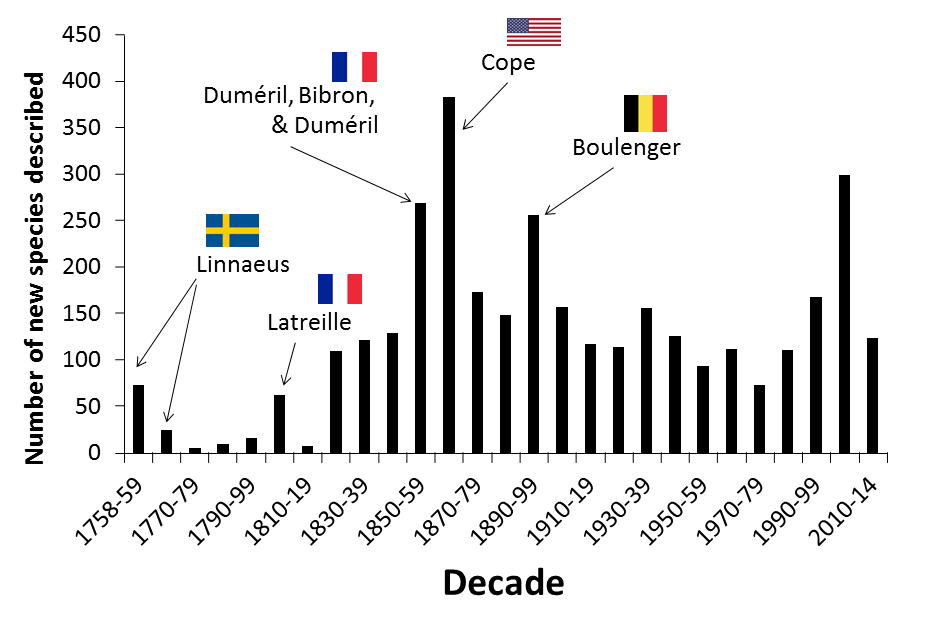 |
| Number of new snake species by decade, with highlights Data from The Reptile Database |
Linnaeus's 1758 Systema Naturae, the starting point of zoological nomenclature, described 118 species of reptiles, including 74 snakes (not counting the limbless lizards and amphibians he included in the same group). It took over 100 years for the number of described species of snakes to reach 1000, an event that probably passed without much notice amid the American Civil War. Since that time, new snake species descriptions have been added at the rate of about 15 a year, although molecular taxonomy has increased this pace over the last few decades. The trends for snakes and for reptiles as a whole have been similar, and on July 9th, 2014, a team of American, German, Lao, and Vietnamese scientists described a new species of gecko from Laos, which the journal Herpetological Review reported as the 10,000th reptile species. Needless to say, I was excited, but I was also extremely disappointed because I had been so hoping that it would be a snake! Rather than admit defeat and scrap this planned post, I emailed Peter Uetz at The Reptile Database, an incredible resource that I've praised before, to confirm that this gecko was indeed #10,000. As usual for taxonomy and as I should have suspected, the reality was a bit more complicated.
Although Cyrtodactylus vilaphongi was the 10,000th reptile species for a while, the order and position of entries in The Reptile Database is constantly changing. Although new species get added to the end of the list, it's common for two or more existing species to get synonymized or merged, which moves the position of all subsequent species up. Furthermore, sometimes species that were described long ago and subsequently synonymized are revalidated, leading to 'new' species that aren't really new in the sense that they have existed before. Finally, often existing species get split up, leading to additions that aren't as dramatic as legitimate new discoveries. This last complication is on the rise now that molecular systematics has enabled us to describe the cryptic diversity of some lineages, which are not all that morphologically distinct but may contain considerable genetic diversity.
At the time of my email to Peter last month, C. vilaphongi was the 9988th species, and (happily), a new snake, Siphlophis ayauma, was #10,000. Although this has probably changed again by now, I'm going to operate under the assumption that, since we can't really say with certainty that any particular species was #10,000, if it was a snake, it was probably one of the 11 brand new snake species that have been described so far this year. You can read about many of these on the blog 'Species New to Science', but I'm going to highlight them in a little more detail here.
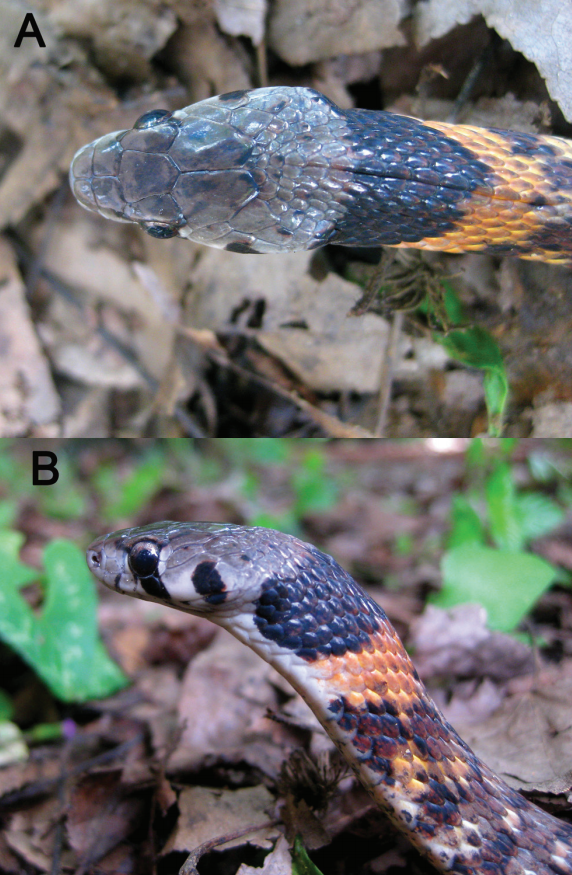 |
| Rhabdophis guangdongensis From Zhu et al. 2014 |
The first new snake described this year, Rhabdophis guangdongensis, was collected by a team of Chinese herpetologists in Guangdong Province in 2008. The reason it wasn't described until the February 20th issue of the journal Zootaxais because, as is often the case, it takes a couple of years to compare both the anatomy and the DNA of a suspected new species to reference specimens of known similar species and establish that the species really is new. In the past, particularly prior to the internet, the difficulty of doing this was a huge problem, resulting in close to half of all 'new' species later being invalidated as duplicates. The genus Rhabdophis is distributed in southern and eastern Asia, and this is the 21st species. It's an extremely interesting genus from a chemical ecology perspective, because at least one species sequesters defensive chemicals from its prey and provisions them to its young (which I wrote about for Scientific American shortly after I started this blog). A recent paper by Yosuke Kojima and Akira Mori on the Japanese species R. tigrinus showed that females periodically leave wetlands for forest streams where they forage on toads, likely to obtain the necessary toxins for provisioning their offspring. The new species also has specialized structures, known as nuchal glands, on the back of its neck, so presumably it stores bufotoxins there as well, although this has yet to be verified.
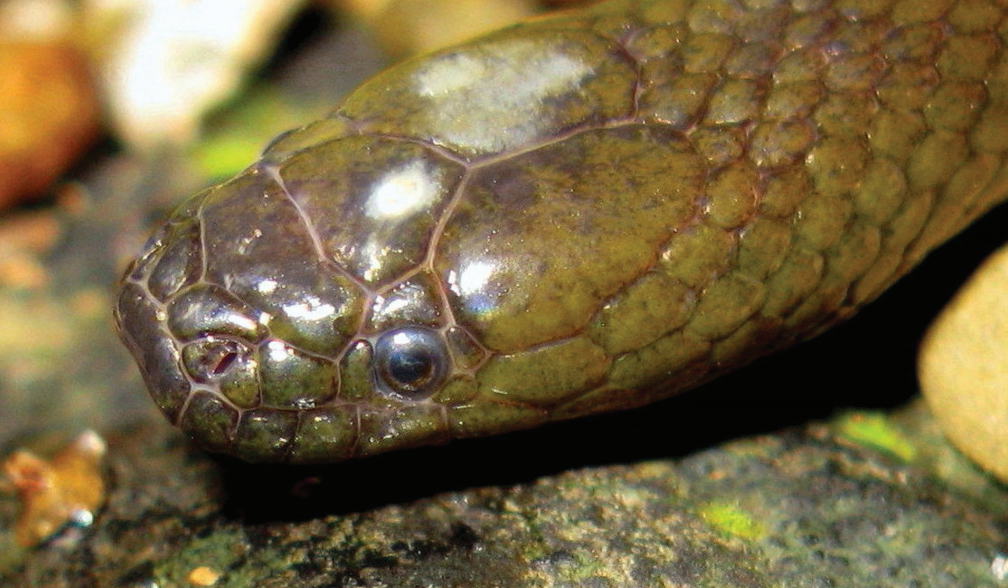 |
| Opisthotropis durandi From Teynié et al. 2014 |
On March 3rd, a team of French, German, and Vietnamese scientists published a description of Opisthotropis durandi, a highly aquatic snake collected from the base of a waterfall in northern Laos. This is the seventh species of Opisthotropis described in the past 20 years, and the first from Laos (although other species are likely to occur there based on their occurrence in surrounding countries). Like the new Rhabdophis, it is also the 21st species in its genus. It is important to realize that, like most species new to science, this snake was already known by local people. It is called Ngou Koung or Ngou Kung, meaning “shrimp snake”, suggesting that it may eat shrimp. The pools at the base of the waterfall where the first specimen was found contained many small shrimp.
 |
| Eutrachelophis bassleri and its weird penis From Myers & McDowell 2014 |
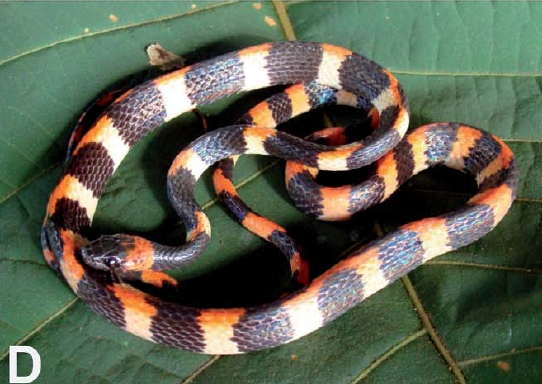 |
| Siphlophis ayauma From Sheehy et al. 2014 |
 |
| Philodryas amaru From Zaher et al. 2014 |
 |
| Causus rasmusseni From Broadley 2014; photo by Paul L. Lloyd |
 |
| Micrurus potyguaraFrom Pires et al. 2014 |
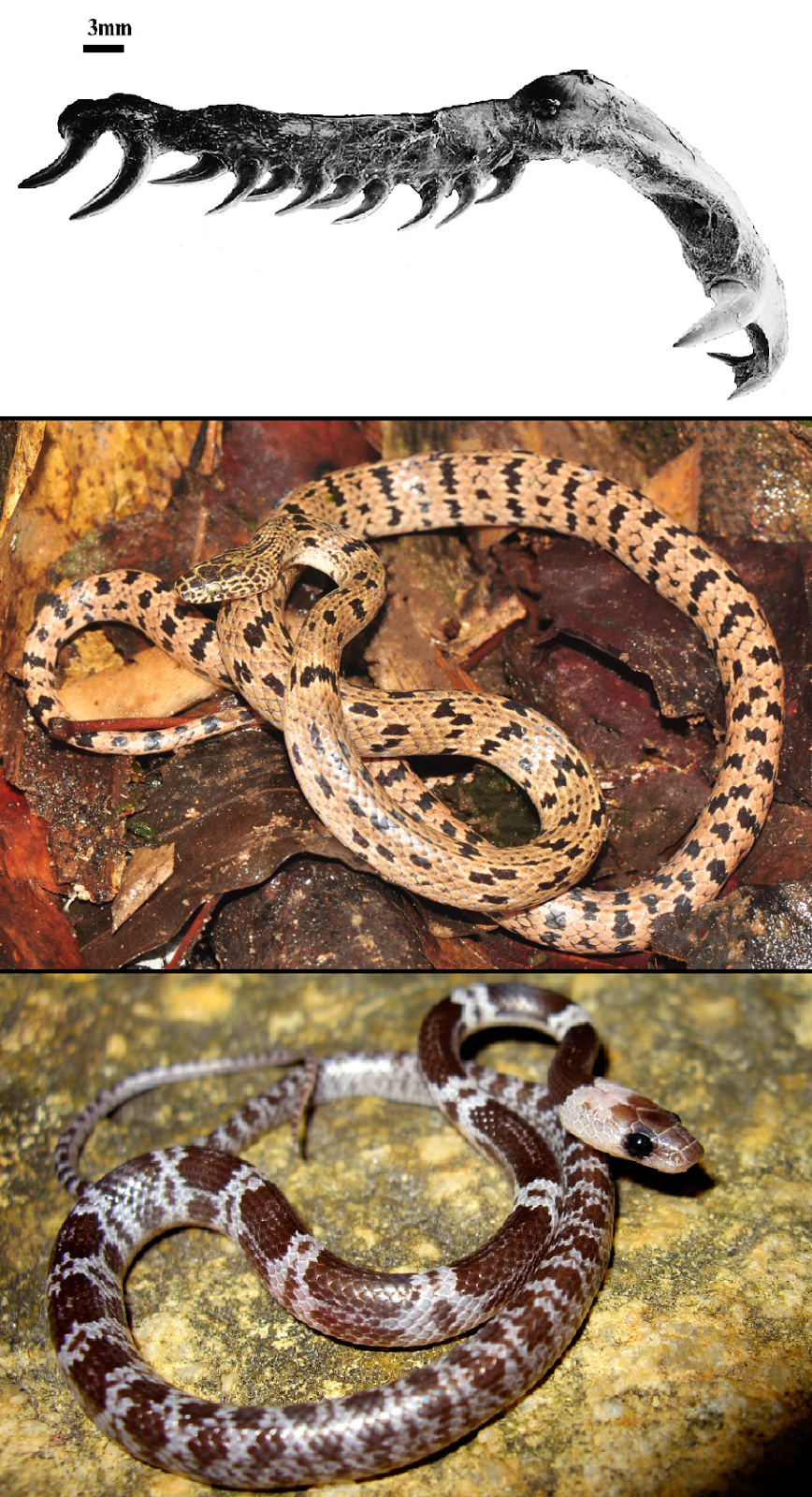 |
| Top: Jaw of Lycodon aulicus From Jackson & Fritts 2004 Middle: Lycodon zoosvictoriae From Neang et al. 2014 Bottom: Lycodon cavernicolus From Grismer et al. 2014 |
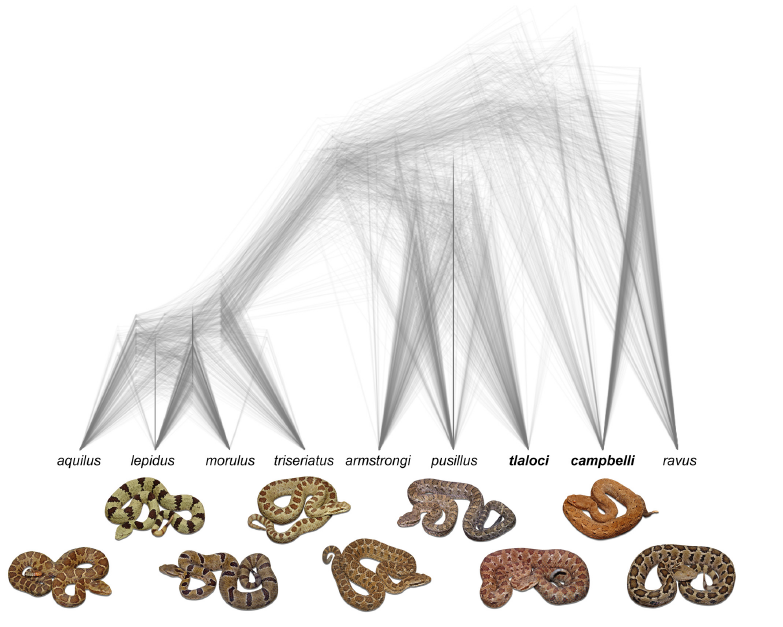 |
| "Cloudogram" of Crotalus triseriatus species group showing the new nine-species arrangement From Bryson et al. 2014 |
 |
| Chironius diamantina From Fernandes & Hamdan 2014 |
In addition to these 15 species, there are a couple of species of snake which were described long ago but that were revalidated recently, including several scolecophidians (Typhlops silus, first described in 1959; Afrotyphlops angeli, first described in 1952; and Letheobia acutirostrata, first described in 1916) and a rattlesnake (Crotalus armstrongi, originally described as a subspecies in 1979 and elevated by the same group that described C. tlaloci and C. campbelli). These are typically announced with less fanfare than the truly new descriptions that I've highlighted above.
Although it's actually been the slowest year for new snakes since 19974, we have 15 new snakes this year, bringing snakes to a total of 3,499 (and 2014 isn't over yet!). We could make it to 3,500 snakes in the same year that we hit 10,000 reptiles. I think these milestones in taxonomy emphasize the importance of reptiles and how much we have left to learn about them. I doubt that the pace of new species descriptions will slow down anytime soon, as experts estimate that less than 15% of the species on Earth have yet been described. Increasingly, reptiles, and snakes in particular, are becoming poster-children for biodiversity and conservation, a welcome change from their history of being overlooked and maligned. Soon, we will have high-quality global range maps for all species of reptiles, an achievement reached some time ago by amphibians, mammals, and birds, which will enable their incorporation into global assessments of vertebrate diversity and conservation planning. It's an exciting time.
Although it's actually been the slowest year for new snakes since 19974, we have 15 new snakes this year, bringing snakes to a total of 3,499 (and 2014 isn't over yet!). We could make it to 3,500 snakes in the same year that we hit 10,000 reptiles. I think these milestones in taxonomy emphasize the importance of reptiles and how much we have left to learn about them. I doubt that the pace of new species descriptions will slow down anytime soon, as experts estimate that less than 15% of the species on Earth have yet been described. Increasingly, reptiles, and snakes in particular, are becoming poster-children for biodiversity and conservation, a welcome change from their history of being overlooked and maligned. Soon, we will have high-quality global range maps for all species of reptiles, an achievement reached some time ago by amphibians, mammals, and birds, which will enable their incorporation into global assessments of vertebrate diversity and conservation planning. It's an exciting time.
ACKNOWLEDGMENTS
REFERENCES
Thanks to Peter Uetz at The Reptile Database for sharing with me some inside information, and to the authors of these papers for their photos.
REFERENCES
 |
| Newspaper clipping from 10 January 1960 showing Broadley with his amputated finger. You can see more at the finger's Facebook page or listen to Broadley describe the experience here. |
Broadley, D. G. 2014. A new species of Causus Lichtenstein from the Congo/Zambezi watershed in north-western Zambia (Reptilia: Squamata: Viperidae). Arnoldia Zimbabwe 10:341-350 <link>
Bryson, R. J., C. W. Linkem, M. E. Dorcas, A. Lathrop, J. M. Jones, J. Alvarado-Diaz, C. I. Grunwald, and R. W. Murphy. 2014. Multilocus species delimitation in the Crotalus triseriatus species group (Serpentes: Viperidae: Crotalinae), with the description of two new species. Zootaxa 3826:475-496 <link>
Cope, E. D. 1895. The classification of the Ophidia. Transactions of the American Philosophical Society 18:186-219 <link>
Dowling, H. G. 1967. Hemipenes and other characters in colubrid classification. Herpetologica 23:138–142 <link>
Cope, E. D. 1895. The classification of the Ophidia. Transactions of the American Philosophical Society 18:186-219 <link>
Dowling, H. G. 1967. Hemipenes and other characters in colubrid classification. Herpetologica 23:138–142 <link>
Grismer, L. L., E. S. H. Quah, S. Anuar, M. A. Muin, P. L. Wood Jr, and S. A. M. Nor. 2014. A diminutive new species of cave-dwelling Wolf Snake (Colubridae: Lycodon Boie, 1826) from Peninsular Malaysia. Zootaxa 3815:51-67 <link>
Guo, P., Q. Liu, L. Zhang, J. X. Li, Y. Huang, and R. A. Pyron. 2014. A taxonomic revision of the Asian keelback snakes, genus Amphiesma (Serpentes: Colubridae: Natricinae), with description of a new species. Zootaxa 3873:425-440 <link>
Fernandes, D. and B. Hamdan. 2014. A new species of Chironius Fitzinger, 1826 from the state of Bahia, Northeastern Brazil (Serpentes: Colubridae). Zootaxa 3881:563-575 <link>
Jackson, K. and T. H. Fritts. 2004. Dentitional specialisations for durophagy in the Common Wolf snake, Lycodon aulicus capucinus. Amphibia-Reptilia 25:247-254 <link>
Köhler, G. and M. Kieckbusch. 2014. Two new species of Atractus from Colombia (Reptilia, Squamata, Dipsadidae). Zootaxa 3872:291-300 <link>
Linnaeus, C. 1758. Systema naturæ per regna tria naturæ, secundum classes, ordines, genera, species, cum characteribus, differentiis, synonymis, locis. Tomus I. Editio decima, reformata. [10th ed.]. Laurentii Salvii, Holmiae, Stockholm, Sweden <link>
Guo, P., Q. Liu, L. Zhang, J. X. Li, Y. Huang, and R. A. Pyron. 2014. A taxonomic revision of the Asian keelback snakes, genus Amphiesma (Serpentes: Colubridae: Natricinae), with description of a new species. Zootaxa 3873:425-440 <link>
Fernandes, D. and B. Hamdan. 2014. A new species of Chironius Fitzinger, 1826 from the state of Bahia, Northeastern Brazil (Serpentes: Colubridae). Zootaxa 3881:563-575 <link>
 |
| Trimeresurus gunaleni From Vogel et al 2014 |
Jackson, K. and T. H. Fritts. 2004. Dentitional specialisations for durophagy in the Common Wolf snake, Lycodon aulicus capucinus. Amphibia-Reptilia 25:247-254 <link>
Köhler, G. and M. Kieckbusch. 2014. Two new species of Atractus from Colombia (Reptilia, Squamata, Dipsadidae). Zootaxa 3872:291-300 <link>
Linnaeus, C. 1758. Systema naturæ per regna tria naturæ, secundum classes, ordines, genera, species, cum characteribus, differentiis, synonymis, locis. Tomus I. Editio decima, reformata. [10th ed.]. Laurentii Salvii, Holmiae, Stockholm, Sweden <link>
Myers, C. W. and S. B. McDowell. 2014. New Taxa and Cryptic Species of Neotropical Snakes (Xenodontinae), with Commentary on Hemipenes as Generic and Specific Characters. Bulletin of the American Museum of Natural History 385:1-112 <link>
Neang, T., T. Hartmann, S. Hun, N. J. Souter, and N. M. Furey. 2014. A new species of wolf snake (Colubridae: Lycodon Fitzinger, 1826) from Phnom Samkos Wildlife Sanctuary, Cardamom Mountains, southwest Cambodia. Zootaxa 3814:68-80 <link>
Pires, M. G., N. J. da Silva Jr., D. T. Feitosa, A. L. d. C. Prudente, G. A. P. Filho, and H. Zaher. 2014. A new species of triadal coral snake of the genus Micrurus Wagler, 1824 (Serpentes: Elapidae) from northeastern Brazil. Zootaxa 3811:569-585 <link>
Salazar-Valenzuela, D., O. Torres-Carvajal, and P. Passos. 2014. A New Species of Atractus (Serpentes: Dipsadidae) from the Andes of Ecuador. Herpetologica 70:350-363 <link>
 |
| Atractus savagei From Salazar-Valenzuela et al. 2014 |
Schneider, N., T. Q. Nguyen, M. D. Le, L. Nophaseud, M. Bonkowski, and T. Ziegler. 2014. A new species of Cyrtodactylus (Squamata: Gekkonidae) from the karst forest of northern Laos. Zootaxa 3835:80-97 <link>
Sheehy, C. M., M. H. Yánez-Muñoz, J. H. Valencia, and E. N. Smith. 2014. A new species of Siphlophis (Serpentes: Dipsadidae: Xenodontinae) from the eastern Andean slopes of Ecuador. South American Journal of Herpetology 9:30-45 <link>
Teynié, A., A. Lottier, P. David, T. Q. Nguyen, and G. Vogel. 2014. A new species of the genus Opisthotropis Günther, 1872 from northern Laos (Squamata: Natricidae). Zootaxa 3774:165-183 <link>
Uetz, P. 2010. The original descriptions of reptiles. Zootaxa 2334:59-68 <link>
Vogel, G., P. David, and I. Sidik. 2014. On Trimeresurus sumatranus (Raffles, 1822), with the designation of a neotype and the description of a new species of pitviper from Sumatra (Squamata: Viperidae: Crotalinae). Amphibian and Reptile Conservation 8:1–29 <link>
Uetz, P. 2010. The original descriptions of reptiles. Zootaxa 2334:59-68 <link>
Vogel, G., P. David, and I. Sidik. 2014. On Trimeresurus sumatranus (Raffles, 1822), with the designation of a neotype and the description of a new species of pitviper from Sumatra (Squamata: Viperidae: Crotalinae). Amphibian and Reptile Conservation 8:1–29 <link>
Zaher, H., J. C. Arredondo, J. H. Valencia, E. Arbeláez, M. T. Rodrigues, and M. Altamirano-Benavides. 2014. A new Andean species of Philodryas (Dipsadidae, Xenodontinae) from Ecuador. Zootaxa 3785:469–480 <link>
Zhu, G.-X., Y.-Y. Wang, H. Takeuchi, and E.-M. Zhao. 2014. A new species of the genus Rhabdophis Fitzinger, 1843 (Squamata: Colubridae) from Guangdong Province, southern China. Zootaxa 3765:469-481 <link>
Life is Short, but Snakes are Long by Andrew M. Durso is licensed under a Creative Commons Attribution-NonCommercial-NoDerivs 3.0 Unported License.
